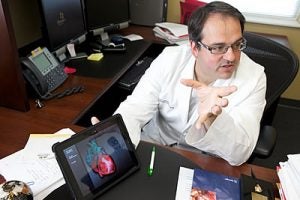Doctors use handheld computers to educate, care for patients
Dr. Evelio Rodriguez has a new way to illustrate for his patients the heart procedures they will be going through.
He takes out an iPad, touches the screen, and a 3D image of a beating heart appears. Rodriguez drags his finger across the screen to rotate the heart. Animated instruments appear, treat areas of the heart, then disappear.

Dr. Evelio Rodriguez
Rodriguez, a cardiothoracic surgeon and associate professor of cardiovascular sciences at East Carolina University, believes the small computer helps patients better understand what’s about to happen than lots of technical jargon.
“I can show them where exactly inside the heart we’re going to be working,” Rodriguez said. “I’ve never had a patient I showed this and they said, ‘I don’t think that helped.'”
The iPad is a line of handheld or tablet computers made by Apple. A little smaller than 8-by-10 inches and weighing about 1.5 pounds, its size puts it between a smart phone and a laptop computer. Many use them primarily as a platform for audio-visual media, communicating and viewing Internet content. With more applications being developed for them every day, however, they are gaining much of the utility of laptop computers without the bulk.
As many as 30 percent of physicians use a tablet device, compared to just 5 percent of U.S. consumers, according to a survey published last month by QuantiaMD, an online learning collaborative. Two-thirds of those doctors use them in a clinical setting. Another 35 percent of physicians surveyed say they are extremely likely to use a tablet within the next few years to help their practice.
Almost all of them use Apple’s tablet computer, though there are competitor models.
At ECU, cardiothoracic surgeons are using the handheld computers for tasks ranging from storing medical information to connecting to health records, images and lab reports to educating patients about their conditions and the procedures they’re about to undergo.
In addition, the small computers allow the doctors to easily interact with their staff and access information between the two East Carolina Heart Institute buildings. That means easier access to patient records and reports, said Jerome Fuller, a technical support analyst at ECU.
“No matter if they’re on this campus, ECHI at ECU, or ECHI at PCMH, that data can live with us, and because of the security protocols on both ends, it’s protected,” Fuller said. Faculty and staff members at the institute have been working with iPads in a variety of ways to assess their usefulness and evaluate and develop patient care and education applications for it.
A company called Biodigital Designs of New York created the animations the heart institute doctors use with their patients. Rodriguez said each animation takes several weeks to create. Some cost as much as $20,000. He and his colleagues also use other animation applications, such as Pocket Heart.
It also allows physicians to work on other projects while away from the office. For example, Dr. W. Randolph Chitwood Jr., director of the institute, is using his iPad to work on a textbook he’s writing, along with patient care tasks. Others work on presentations, plan events and manage their calendars. Dr. Joseph Elbeery, who works in the intensive care unit of the ECHI at Pitt County Memorial Hospital, uses it to show educational videos to patients.
Program associate Beth Bengala prefers the smaller, more portable iPad to a bulky laptop computer for taking notes at meetings, keeping physician calendars handy and other on-the-go tasks. “It’s definitely made my job a lot easier and a lot smoother,” she said.